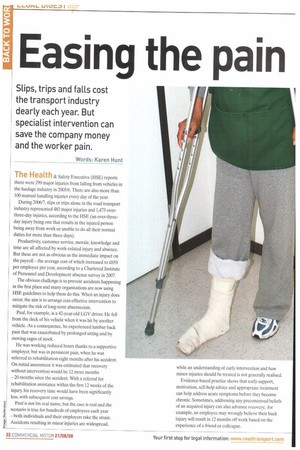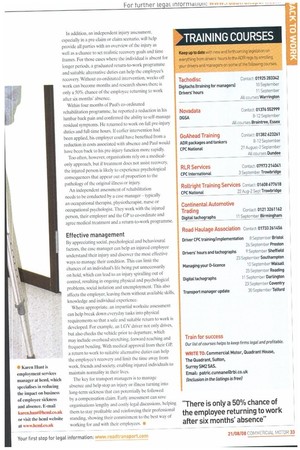Easing the pain
Page 32

Page 33

If you've noticed an error in this article please click here to report it so we can fix it.
Slips, trips and falls cost the transport industry dearly each year. But specialist intervention can save the company money and the worker pain.
Words: Karen Hunt
The Health& Safety Executive (HSE) reports there were 299 major injuries from falling from vehicles in the haulage industry in 2005/6. There are also more than 100 manual handling injuries every day of the year.
During 2006/7, slips or trips alone in the road transport industry represented 483 major injuries and 1,473 overthree-day injuries, according to the HSE (an over-threeday injury being one that results in the injured person being away from work or unable to do all their normal duties for more than three days).
Productivity, customer service, morale, knowledge and time are all affected by work-related injury and absence. But these are not as obvious as the immediate impact on the payroll — the average cost of which increased to £659 per employee per year, according to a Chartered Institute of Personnel and Development absence survey in 2007.
The obvious challenge is to prevent accidents happening in the first place and many organisations are now using HSE guidelines to help them do this. When an injury does occur, the aim is to arrange cost-effective intervention to mitigate the risk of long-term absenteeism.
Paul, for example, is a 42-year-old LGV driver. He fell from the deck of his vehicle when it was hit by another vehicle. As a consequence, he experienced lumbar back pain that was exacerbated by prolonged sitting and by moving cages of stock.
He was working reduced hours thanks to a supportive employer, but was in persistent pain, when he was referred to rehabilitation eight months after his accident. On initial assessment it was estimated that recovery without intervention would be 12 more months — 20 months since the accident. With a referral for rehabilitation assistance within the first 12 weeks of the injury, his recovery time would have been significantly less, with subsequent cost savings.
Paul is not his real name, but the case is real and the scenario is true for hundreds of employees each year — both individuals and their employers take the strain. Accidents resulting in minor injuries are widespread, while an understanding of early intervention and how minor injuries should be treated is not generally realised.
Evidence-based practice shows that early support, motivation, self-help advice and appropriate treatment can help address acute symptoms before they become chronic. Sometimes, addressing any preconceived beliefs of an acquired injury can also advance recovery; for example, an employee may wrongly believe their back injury will result in 12 months off work based on the experience of a friend or colleague. In addition, an independent injury assessment, especially in a pre-claim or claim scenario, will help provide all parties with an overview of the injury as well as a chance to set realistic recovery goals and time frames. For those cases where the individual is absent for longer periods, a graduated return-to-work programme and suitable alternative duties can help the employee's recovery. Without co-ordinated intervention, weeks off work can become months and research shows there is only a 50% chance of the employee returning to work after six months' absence.
Within four months of Paul's co-ordinated rehabilitation programme, he reported a reduction in his lumbar back pain and confirmed the ability to self-manage residual symptoms. He returned to work on full pre-injury duties and full-time hours. It' earlier intervention had been applied, his employer could have benefited from a reduction in costs associated with absence and Paul would have been back to his pre-injury function more rapidly.
Too often, however, organisations rely on a medicalonly approach, but if treatment does not assist recovery, the injured person is likely to experience psychological consequences that appear out of proportion to the pathology of the original illness or injury.
An independent assessment of rehabilitation needs to be conducted by a case manager — typically an occupational therapist, physiotherapist, nurse or occupational psychologist. They work with the injured person, their employer and the GP to co-ordinate and agree medical treatment and a return-to-work programme.
Effective management
By appreciating social, psychological and behavioural factors, the case manager can help an injured employee understand their injury and discover the most effective ways to manage their condition. This can limit the chances of an individual's life being put unnecessarily on hold, which can lead to an injury spiralling out of control, resulting in ongoing physical and psychological problems, social isolation and unemployment. This also affects the employer, leaving them without available knowledge and individual experience.
Where appropriate, an impartial worksite assessment can help break down everyday tasks into physical requirements so that a safe and suitable return to work is developed. For example, an 1.0V driver not only drives, but also checks the vehicle prior to departure, which may include overhead stretching, forward reaching and frequent bending. With medical approval from their OP, a return to work to suitable alternative duties can help the employee's recovery and limit the time away from work, friends and society, enabling injured individuals to maintain normality in their lives.
The key for transport managers is to manage absence and help stop an injury or illness turning into long-term sickness that can potentially be followed by a compensation claim. Early assessment can save organisations lengthy and costly legal discussions, helping them to stay profitable and reinforcing their professional standing, showing their commitment to the best way of working for and with their employees. •












































































































































































